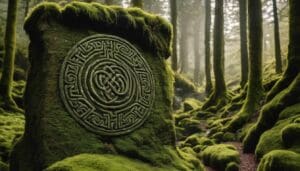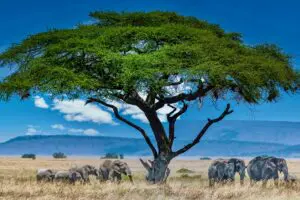The Limestone Vistas of The Burren: Exploring Ireland’s Geological Wonder
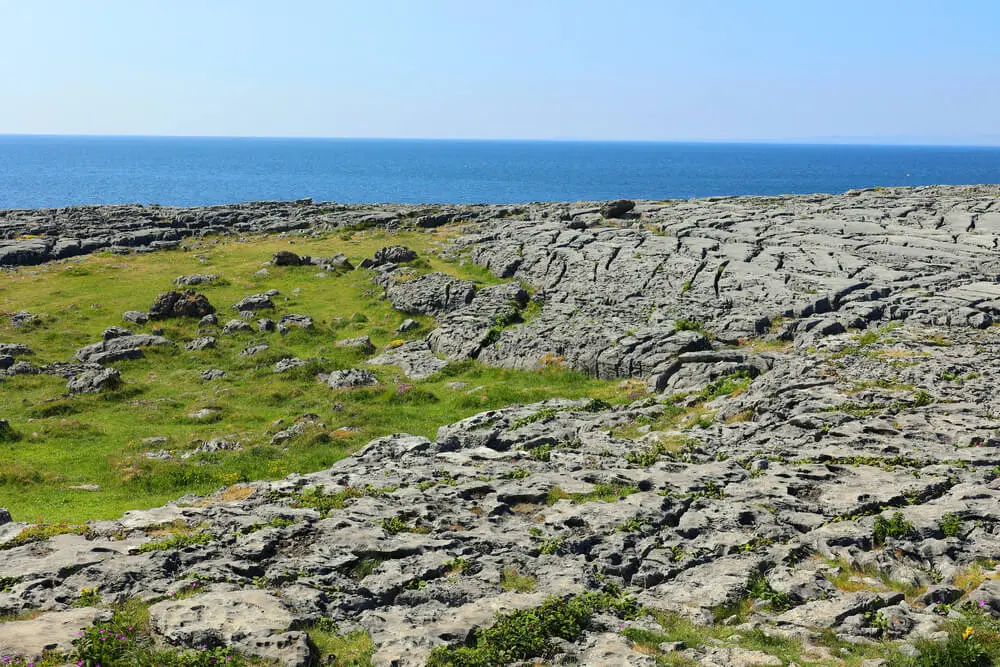
Updated On: April 24, 2024 by Yasmin Elwan
Nestled in the heartland of Ireland, The Burren presents a geological masterpiece that is as captivating as it is unique. With a tapestry of limestone stretching over 250 square kilometres, this karst landscape is a testament to nature’s artistry over millions of years. Each slab and fissure tells a story of ancient seas, prehistoric life, and the relentless forces of erosion and time.
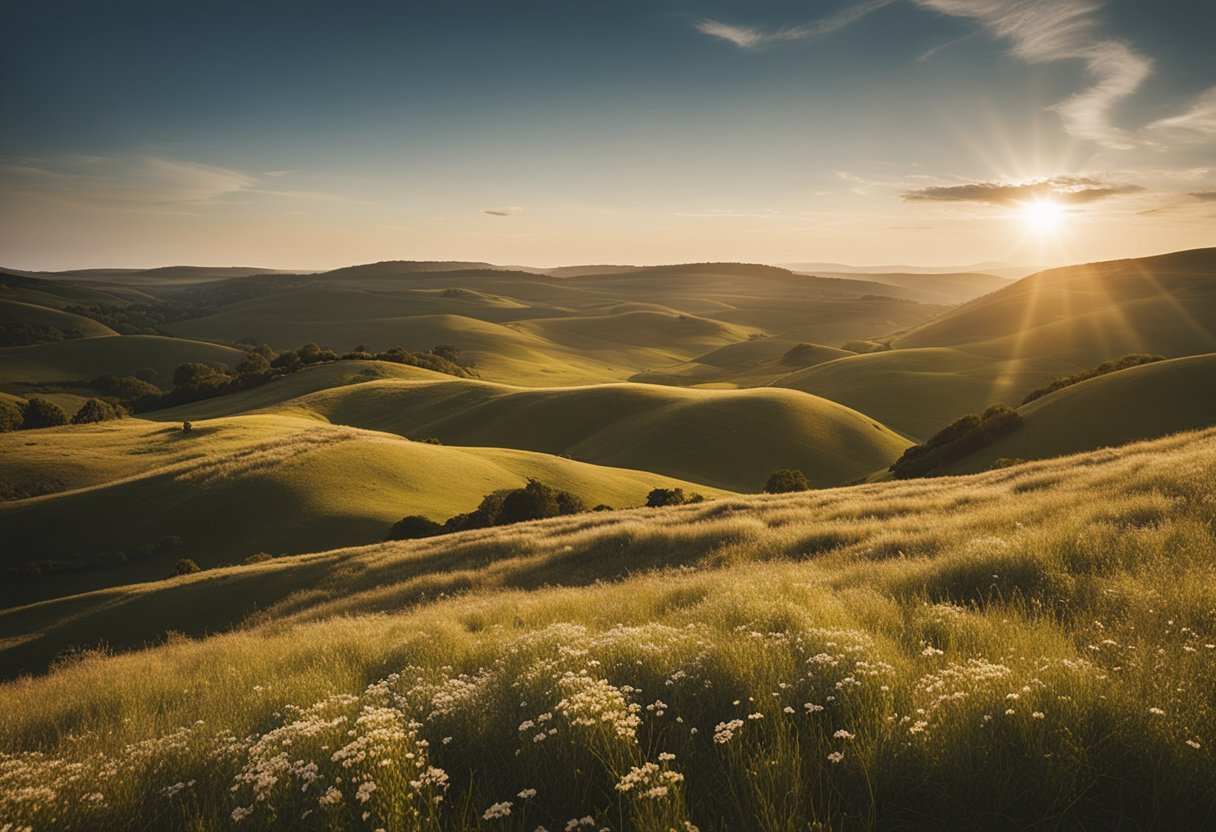
As we trace the evolution of this austere beauty, The Burren reveals more than just its rough-hewn surface. It is home to an astonishing array of flora and fauna, some of which are found nowhere else on Earth. This biodiversity hotspot is a convergence of arctic, alpine, and Mediterranean species, thriving in an intricate ecosystem shaped by the limestone’s porous canvass. Far from being a barren expanse, The Burren brims with life, its landscapes a striking contrast of rugged stone and delicate blooms.
Our interaction with this region has only deepened its allure. From the megalithic tombs of our ancestors to modern conservation efforts, The Burren stands as a living archive of human history and natural heritage. It is a place where the past is always present and where the whisper of ancient tales is carried on the wind, across the wild Atlantic coastline and through the timeless stone.
Geological Formation of The Burren
In this section, we uncover the fascinating story of The Burren’s geological formation, taking a deep look at its ancient limestone composition, its reshaping by glaciers, and the development of its unique karst landscape.
Carboniferous Limestone and Fossil Records
The bedrock of this place primarily consists of Carboniferous limestone, which was formed roughly 359 to 299 million years ago. During this Carboniferous Period, the area which is now The Burren was located near the equator and submerged under a warm, shallow sea. This environment facilitated the accumulation of sediment rich in calcium carbonate from the marine organisms. Over time, these sediments compacted and solidified into limestone, encapsulating a myriad of fossilised remains. Fossils in this region display a historical record of marine life, including corals and sea urchins that once flourished in those tropical waters.
Effects of the Ice Age and Glacial Erratics
Several Ice Ages have sculpted The Burren’s landscape, with the most recent one occurring approximately 12,000 years ago. The immense power of the glaciers altered the land, stripping away much of the soil and leaving behind raw limestone pavements. As these glaciers moved, they carried with them a variety of rocks, known as glacial erratics, which were deposited haphazardly across the place as the ice melted. These erratics can range from small pebbles to massive boulders and can be composed of a variety of rock types that differ from the native Carboniferous limestone.
Karst Landscape Development
The Burren is renowned for its distinctive karst topography, a landscape formed by the dissolution of soluble rocks such as limestone. Rainwater, which is naturally acidic due to dissolved carbon dioxide, percolates through cracks in the limestone, gradually enlarging them to create features such as underground caves, clints (blocks of limestone), and grikes (fissures).
These structures allow for remarkable biodiversity and distinctive ecosystems to develop in The Burren despite the seeming barrenness of the rocky surface. The term ‘karst’ itself is a testament to the water’s role in carving out this remarkable limestone tableau over thousands of years.
The Flora and Fauna of The Burren
The Burren, with its limestone canvases, captivates us with a symphony of life that thrives in this harsh yet stunning environment. Here, we find a blend of unique plant species alongside diverse fauna, each carving out a niche in this seemingly austere landscape.
Unique Plant Species and Their Adaptations
In the rocky expanse of The Burren, plant life exhibits remarkable adaptations. Spring Gentian, known for its vivid blue hues and mountain avens, withstand the demands of the high oceanic climate. The presence of rare orchids adds to the area’s botanical allure, with each species utilising the thin soil and fissures in the limestone to anchor and nourish themselves. These flowering plants, which include a spectrum from ferns to wildflowers, rotate with the seasons, ensuring The Burren is never devoid of bloom.
Wildlife Habitats and Biodiversity
The Burren’s unique topography creates a mosaic of habitats, fostering an impressive biodiversity. We observe a range of fauna, including the elusive pine marten and a variety of butterflies that find refuge amongst these calcareous grasslands. This blend of habitats protects a plethora of species, and the conservation efforts ensure a sustainable coexistence. Our exploration here reminds us that each species, from the smallest insect to the most agile mammal, contributes meaningfully to The Burren’s ecological tapestry.
Burren’s Signature Landscapes
The Burren in Ireland poses a remarkable tapestry of limestone landscapes, each with its unique historical significance and natural beauty. These landscapes harbour a rich tapestry of geological, archaeological, and ecological assets that beckon exploration.
Cliffs of Moher: Majestic Sea Cliffs
The Cliffs of Moher stand as imposing sentinels along the Atlantic edge of the Burren. Rising to a height of over 200 metres, these cliffs are a testament to the power of the sea and wind, shaped over millions of years. Visitors are drawn here not just for the stunning views, but also to appreciate the geological narratives captured within these formidable rock faces. The Cliffs are part of The Burren and Cliffs of Moher UNESCO Global Geopark, recognising their global significance and ongoing conservation efforts.
The Limestone Pavements and Grikes
Characterised by an expansive network of limestone pavements and grikes, this geological masterpiece’s landscape is a natural mosaic of rock, flora, and fauna. The pavements are crisscrossed by deep fissures known as grikes, sheltering a unique ecosystem within. Remarkably, the Burren supports plant species from contrasting habitats, ranging from the Arctic to the Mediterranean, all coexisting within this calcareous terrain. This results from the pavement’s ability to retain heat and nutrients, creating microenvironments perfect for biodiversity to thrive.
Poulnabrone Dolmen and Neolithic History
At over 5,000 years old, the Poulnabrone Dolmen is not just an ancient stone tomb; it’s a portal to the Neolithic period. This iconic portal tomb, with its massive capstone resting on vertical slabs, is one of Ireland’s most photographed archaeological sites. The Poulnabrone Dolmen provides us with an intimate link to the region’s early human inhabitants, with excavations revealing insights into their burial rituals and daily lives. Exploring this megalithic structure allows us to connect with the profound sense of history that emanates from the very stones of the Burren.
Karst Features and Their Formations
The Burren’s landscape is a fascinating geological mosaic where karstification has left a remarkable imprint. Through the dissolution of limestone by acidic rainwater, an array of karst features has been sculpted, each narrating a tale of millions of years of environmental interaction.
Caves and Cave Formations
Limestone is largely composed of calcium carbonate, which is susceptible to erosion by slightly acidic water. When rainwater absorbs carbon dioxide, it forms a weak carbonic acid that gradually dissolves limestone as it seeps through its cracks, eventually creating caves. Within these subterranean wonderlands, striking formations like stalactites and stalagmites emerge as water, rich in calcium, drips and recrystallises.
Fissures, Grikes, and Clints
- Fissures: Narrow, deep cracks in the limestone called fissures arise from the expansion and contraction of rock, exacerbated by water erosion. Over time, these fissures can become extensive cave systems.
- Grikes and Clints: The iconic lattice work on the Burren’s surface comprises grikes—vertical fissures widened by the dissolution process—flanked by blocks of limestone called clints. This distinctive pattern is the hallmark of a karst landscape, revealing clues about the direction of water flow and the underlying cave architecture.
Human Interaction and the Burren
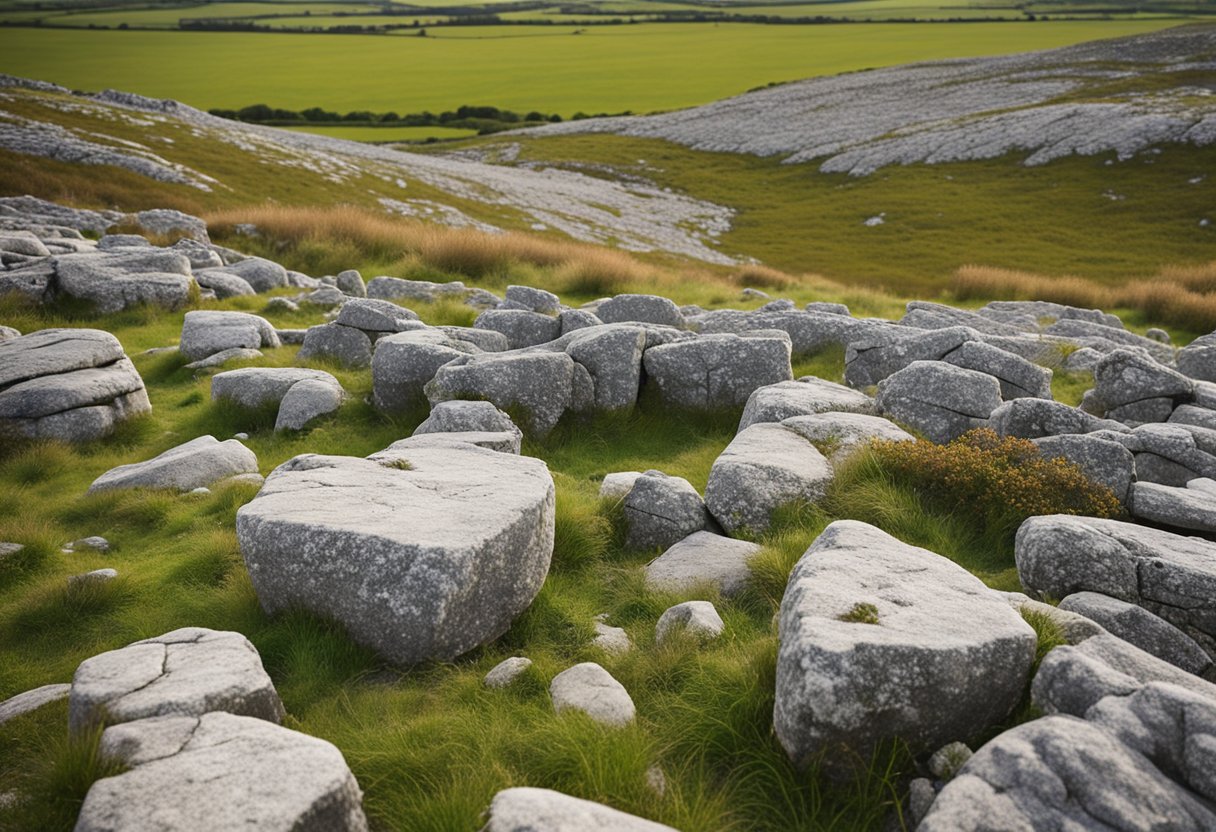
The Burren, with its dramatic limestone landscapes, not only carries a geological and ecological significance but is also a testament to the enduring human presence that has shaped it through countless generations. This section delves into the practical aspects of this interaction, specifically focusing on historical and current land use, as well as the implications of tourism on the region’s economy.
Historical Land Use and Farming Practices
The Burren’s unique landscape, while appearing austere, has been fertile ground for innovative farming practices for millennia. We observe evocative evidence of this through the remnants of ancient fields and settlement sites interspersed across the terrain.
Historically, farming in the Burren has adapted to its surroundings, featuring a system known as ‘winterage’, which is the practice of grazing livestock on the nutrient-rich grasslands during the winter months. This method not only caters to the well-being of the livestock during harsher months but simultaneously safeguards the delicate ecosystem by preventing overgrazing during the summer.
Tourism in The Burren and its Economic Impact
The haunting allure of the Burren’s landscape is a major draw for visitors, with tourism playing a significant role in the local economy. Towns like Lisdoonvarna and Doolin have become hubs for tourists seeking to engage with the region’s rich history and explore its natural beauty.
Tourism not only offers an alternative source of income to traditional farming but also presents challenges in balancing economic gains with environmental conservation. Through guided walks, heritage centres, and eco-friendly tours, we attempt to educate visitors on the importance of preserving the Burren’s unique landscape while simultaneously sustaining the local economy.
Our interactions with the Burren, be it through farming or tourism, underscore the continuous dialogue between us and our environment and the importance of sustainable practices for the future health of this storied landscape.
The Burren’s Coastal Ecosystem
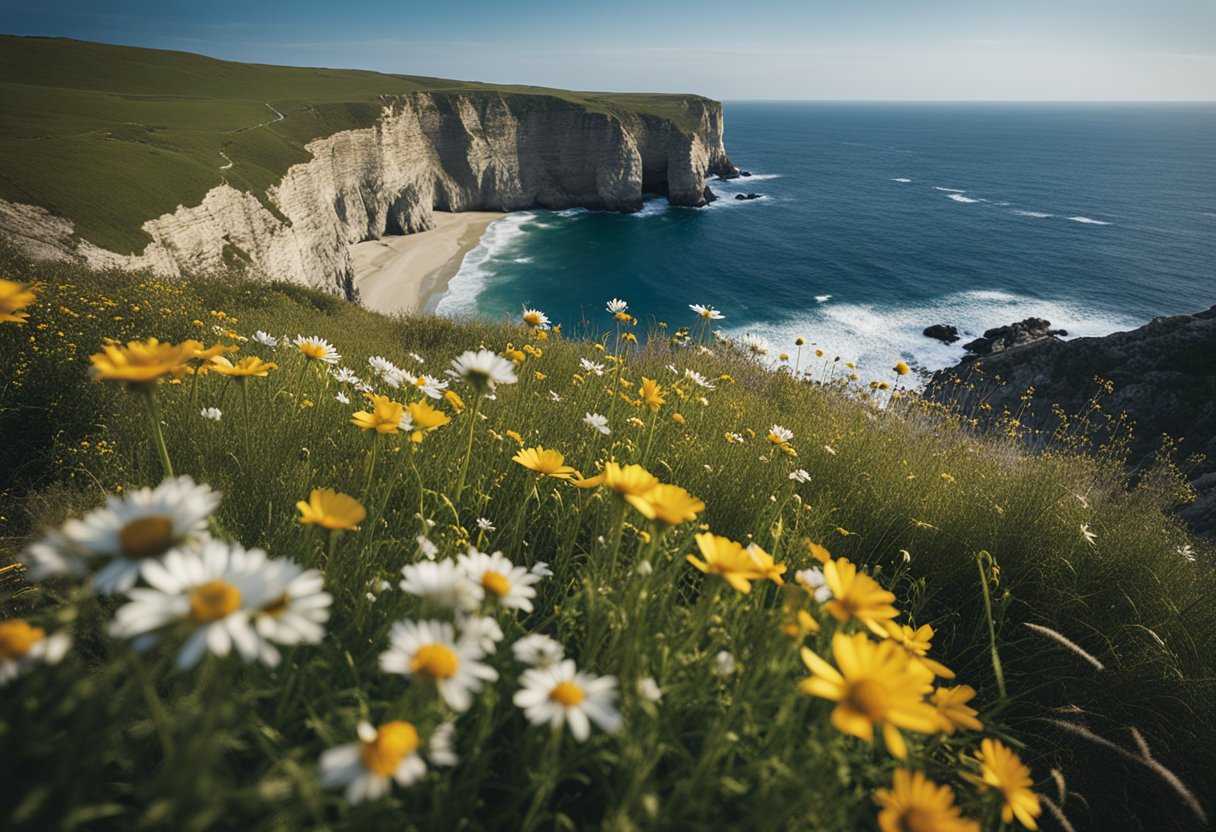
Encompassing a unique convergence of land and sea, the coastal ecosystem of The Burren tells a remarkable tale of geological and biological collaboration. Here, the relentless forces of the Atlantic have shaped a coastline teeming with life and geological intrigue.
Impact of Sea and River Systems
Atlantic Ocean currents and river systems have carved the dramatic coastline of The Burren, exerting a profound impact through erosion. Limestone cliffs, etched by the persistent action of waves, stand as sentinels watching over the sea. They bear witness to the power of natural elements in sculpting the landscape over millennia. Rivers, having travelled across the limestone pavement, meet the ocean, depositing minerals that support a diverse array of marine organisms.
Marine Organisms and Shoreline Features
The interplay of land and sea has created a rich tapestry of shoreline features characterised by rock pools and sea caves, home to a variety of marine organisms. These tidal pools teem with life: crustaceans, fish, and anemones all thrive in these microcosms, a testament to the region’s biodiversity. The coastline, shaped by both the land’s resistance and the sea’s insistence, reveals layers of exposed rock that hide myriad secrets of The Burren’s past.
Conservation Efforts in The Burren
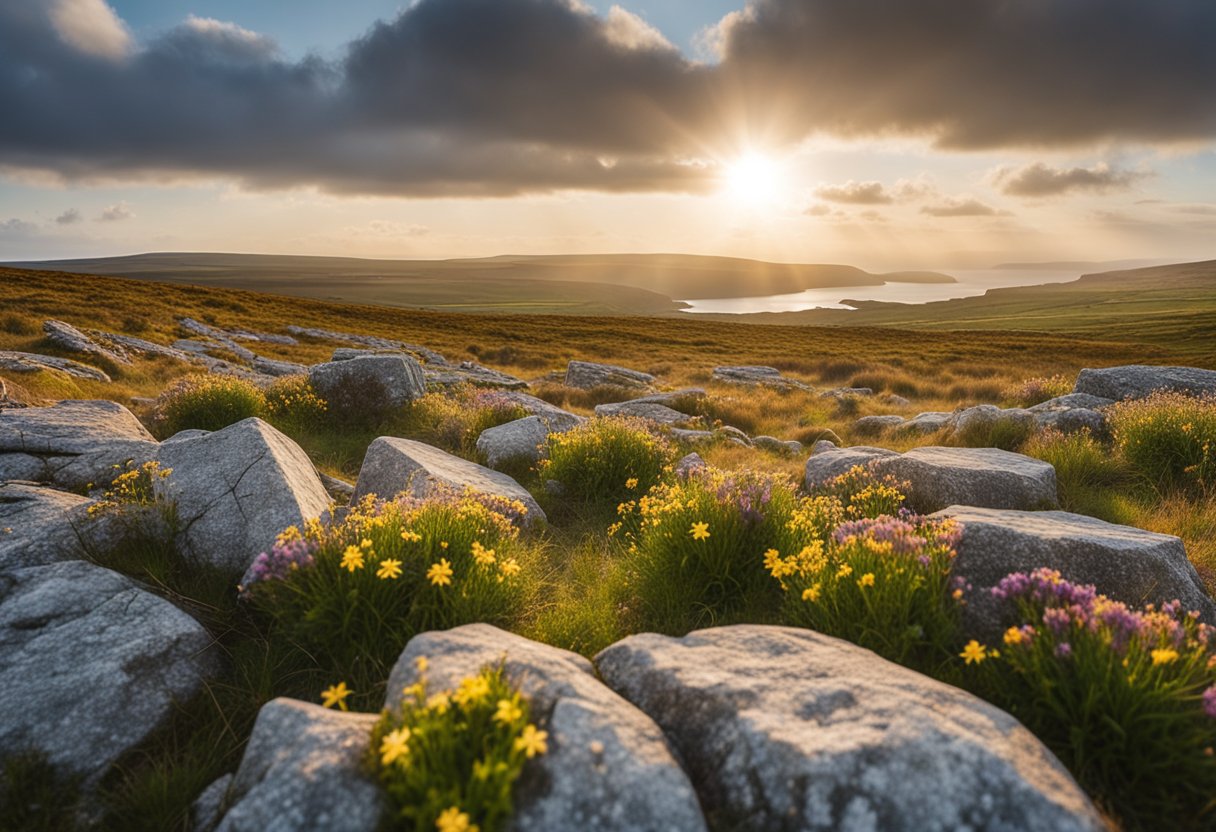
We are committed to maintaining the breathtaking charm and ecological significance of The Burren. As such, a variety of conservation efforts are paramount to preserve this unique environment.
The Burren and Cliffs of Moher Geopark
The Burren and Cliffs of Moher Geopark is a celebrated member of the European Geoparks Network, focused on conservation and education. Its designation as a Geopark reflects not only the geological importance of the region but also the ongoing commitment to maintaining its delicate balance. Through the Geopark, we engage in programmes that aim to educate visitors and locals alike about the value of our natural heritage, encouraging sustainable tourism and protective measures that ensure this landscape remains preserved for future generations.
Sustainable Practices and Environmental Protection
Sustainable practices lie at the heart of environmental protection in The Burren. We prioritise features such as limestone pavement conservation, which includes the protection of rare habitats and the promotion of sustainable agriculture that coexists harmoniously with nature. Local farmers are encouraged to adopt environmentally friendly practices, such as low-intensity farming, which align with the environmental goals for the area.
Our efforts to safeguard the diverse species that inhabit The Burren’s ecosystems are supported by regulatory measures like the EU Habitats Directive. These comprehensive strategies contribute to the Burren’s endurance as a symbol of natural splendour and biodiversity.
Recreational Activities in The Burren
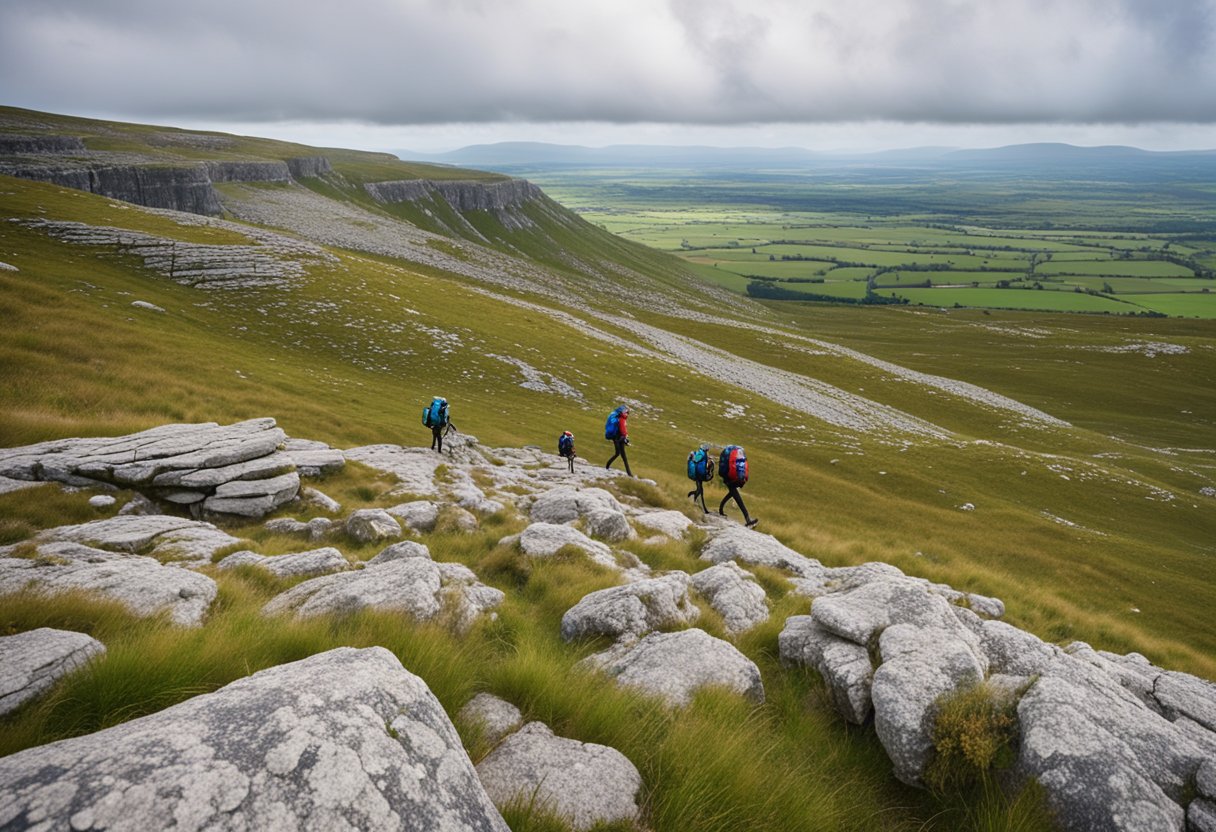
The Burren’s unique karst landscape is not just a feast for the eyes, it’s a playground for outdoor enthusiasts. From the craggy limestone pavements to the lush green hills, there’s a variety of activities that offer a deeper connection to this majestic area of natural beauty.
Hiking and Walking Trails
We find the network of trails throughout the region ideal for keen walkers and hikers. The terrain ranges from gently sloping hills to more challenging rocky ascents, which means there’s something for every fitness level:
- Burren Way: A signposted long-distance trail that takes you past some of the most picturesque spots, including the historical village of Ballyvaughan and the spectacular Cliffs of Moher.
- Caher Valley Loop: This trail allows hikers to immerse themselves in nature, with chances to spot unique flora and fauna among the limestone fissures.
The natural allure of The Burren unfolds before us as we traverse its ancient paths, each step revealing a different shade of its storied landscape.
Rock Climbing and Adventure Sports
For adventurers seeking a more adrenaline-fueled experience, The Burren’s rugged relief provides the perfect setting for rock climbing. The region’s limestone cliffs offer a variety of routes that cater to both beginners and experienced climbers. Exploring The Burren through climbing allows us to engage intimately with the rock formations that have stood for millennia.
- Ailladie: Known for its sea cliffs, it is a premium spot for sport climbing, with the waves crashing below adding to the thrill.
- Bouldering opportunities: Scattered throughout The Burren, there are ample bouldering challenges, inviting climbers to test their strength and skill against this dynamic landscape.
Whether it’s the physical challenge or the stunning views from atop a limestone crag that draws us, rock climbing in The Burren is sure to leave an indelible mark on our outdoor adventures.
Educational Resources and Research
In The Burren, educational resources and rigorous research offer unmatched opportunities for learning about its unique geological story. Our focus on geology and visitor education ensures that there are ample resources available, from the informative Visitor Centre to in-depth geological field research.
Visitor Centre and Guided Tours
The Visitor Centre serves as a hub of education and insight into the geology of The Burren. Visitors can immerse themselves in interactive exhibits that explain the formation of this limestone landscape. Additionally, guided tours provide a hands-on educational experience. Led by knowledgeable geologists, these tours allow enthusiasts and students alike to explore The Burren’s features up close, enriching their understanding of the region’s complex history.
Geological Studies and Field Research
For those wishing to pursue more formal geological studies, this place is a living classroom. Academics and researchers conduct extensive field research, contributing to a growing body of knowledge about this special place. Collaborative efforts between universities and geoparks enhance the educational offerings, providing both undergraduate and postgraduate geologists with invaluable fieldwork opportunities to study The Burren’s intricate stone tapestry.
Cultural Heritage of The Burren
The Burren captivates with a rich cultural tapestry, woven from its ancient archaeological sites to the thriving local customs and music found in its heartland communities, such as Lisdoonvarna and Doolin. These elements, rooted deeply in history, offer a glimpse into a past where every artefact and legend tells a story.
Traditional Music and Local Customs
In the quaint villages of Doolin and Lisdoonvarna, we find ourselves immersed in the traditional music scene, recognised as a vibrant part of The Burren’s cultural heritage. The melodies resonating from pub sessions and music festivals are a testament to the area’s long-standing musical tradition. Local customs, from dance to storytelling, continue to thrive, fostering a community deeply connected by its cultural expressions.
- Doolin: Renowned for its traditional Irish music sessions.
- Lisdoonvarna: Famous for its annual matchmaking festival.
Myths, Legends, and Archaeological Sites
The Burren is a landscape etched with tales from the Neolithic period through to medieval times. Myths and legends abound, with folklore steeped in the very stones of the numerous archaeological sites scattered across this karst terrain. Among these, the Poulnabrone dolmen, a portal tomb dating back over 5,000 years, stands as a mute witness to the millennia of history. Artefacts unearthed throughout The Burren provide invaluable insights into the lives of its ancient inhabitants.
- Poulnabrone dolmen: An iconic Neolithic portal tomb.
- Archaeological finds: Tools, pottery, and other artefacts illuminated centuries of history.
Frequently Asked Questions
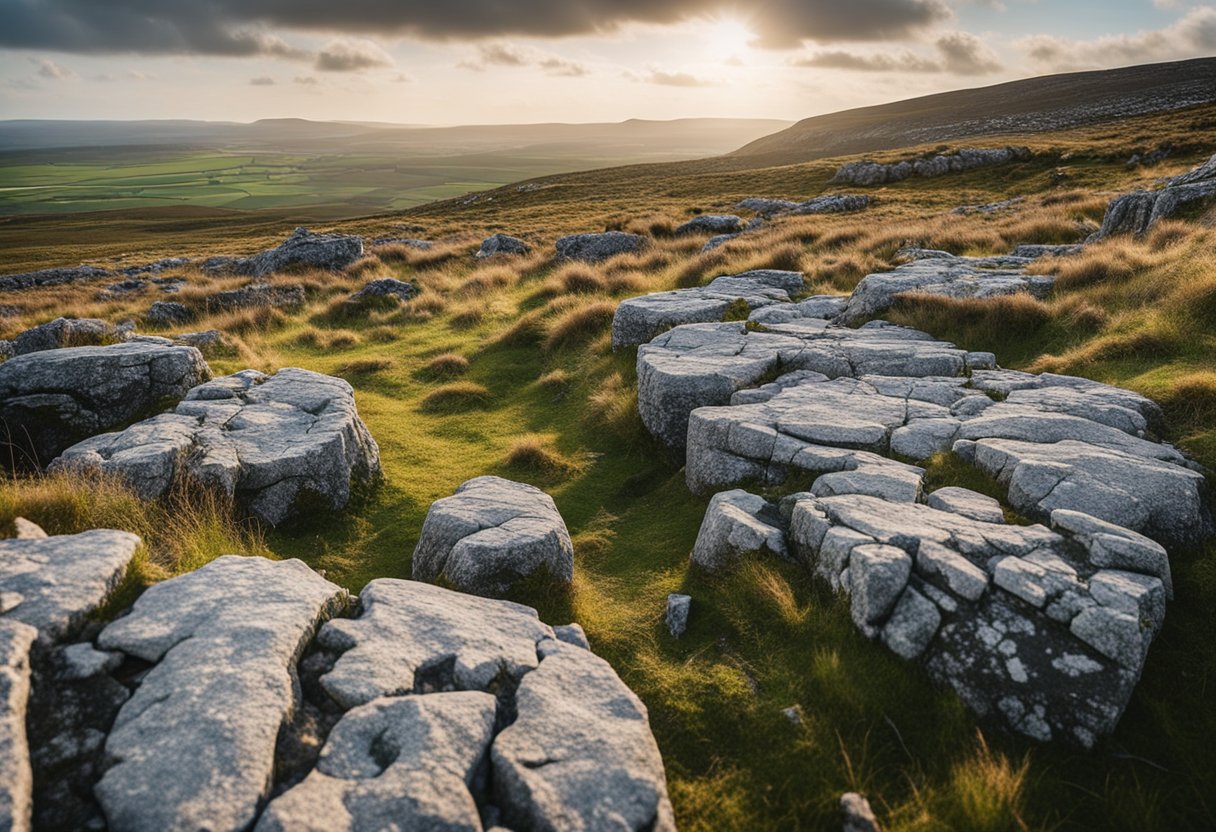
We’ve compiled a list of frequently asked questions to enhance your understanding of The Burren’s unique geological landscape.
For what reasons is the Burren renowned?
The Burren is renowned for its exceptional geology, diverse flora and fauna, and rich cultural history. It is recognised for the remarkable variety of plants and animals that coexist on the limestone pavements, as well as significant archaeological sites.
Can you list ten interesting details about the Burren?
- The Burren spans approximately 360 square kilometres of karst landscape.
- It features glacial and solutional landforms.
- The region is home to over 70% of Ireland’s native plant species.
- Numerous ancient megalithic tombs are scattered across The Burren.
- The Burren’s geological formation contributes to its unique biodiversity.
- Alpine, Mediterranean, and Arctic plants grow side by side due to unique soil conditions.
- It has been inhabited since the Stone Age.
- It displays rare geomorphological features like clints and grikes.
- It comprises some of the most extensive cave systems in Ireland.
- The Burren supports a vibrant community of artisan producers and craft workers.
What makes the Burren so crucial as a region of national significance?
The Burren’s importance stems from its unparalleled geological features, historical significance, and biodiversity, which covers a wide range of habitats. These factors combine to make the Burren a critical area for scientific study and conservation.
From what materials does the Burren landscape primarily consist?
The Burren landscape predominantly consists of limestone bedrock, exposed in many areas as bare pavements, with occasional areas of siltstone, shale, and sandstone.
What is the age of the limestone found in the Burren?
The limestone in the Burren dates back to the Carboniferous period, making it around 320 million years old. Its rich fossil content provides valuable insights into ancient marine environments.


